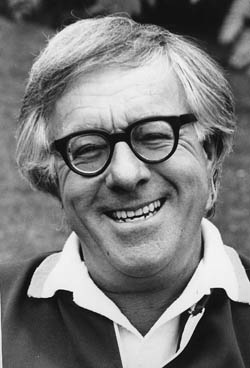It took two magical words, “public library,” to get Ray Bradbury to speak at the 2002 Santa Barbara Book & Author Festival. When we said, “This festival partners with the Santa Barbara Public Library,” he responded with a fast yes. That year, the festival had the largest crowd in its eight-year history.
Bradbury’s gratitude to public libraries is legendary. As a Depression-era teen, his parents could not send him to college but sent him out to sell newspapers. He told audiences he got his education by going to the library three days a week for 10 years.
In 1950, he fed a dime into UCLA library typewriters every half hour. By the time he had typed the 25,000-word manuscript of The Fireman, he’d spent $9.80, or $93.71 in today’s dollar. That manuscript, published in 1951, was expanded and published in 1953 as Fahrenheit 451, probably his most famous book and movie.
When Bradbury walked onto the stage at the Santa Barbara Writers Conference (SBWC) every year for 34 years … Wait, back up that reel. Bradbury never walked onto a stage. He bounded, leaped, or jumped onto it. Wearing tennis whites with white knee socks, he would rush to the microphone, glance at the audience through his magnifying-glass–thick horn-rimmed specs, and proclaim, “What if?”

His words hung in the air. We students sat as if a literary god had been sent down to the Miramar Hotel (and later Westmont College and the DoubleTree Resort). You had to be in awe of an author who, by the end of his life on June 5 at age 91, had written 27 novels and more than 600 short stories — not only critically acclaimed but popular — as well as children’s stories, poetry, and plays.
When given this assignment, I searched for and found my SBWC notebook, filled with jottings over the years, and most of them were gone. Somehow, the notebook had gotten soaked, the writing obliterated. I was sick.
That night I awoke with writer’s dread: What to say? I turned on the light. There, on a stack of books on the bedside table, sat Dandelion Wine. I opened the first page, ready to reenter Green Town, where the novel takes place. Instead, there was Bradbury’s four-page introduction — on writing. It was like a personal gift from the man himself, using many of the same words used to inspire us writers at the conference.
Bradbury would trigger our imaginations with suggestions fired like automatic gunfire. “What if you’re riding in a train when you look out the window and see …?” “What if the man across the aisle from you suddenly …?” “What if? That’s what gets the creative juices going.”
Just as we would catch our breath, he’d feed our minds more. “Use your imagination! Just for fun, take along your favorite authors on an all-night train ride. Choose ones you’d like to talk to. Spend the night with them. Imagine what they’d say, the questions you’d ask, what you’d talk about. I’d choose Dickens, G. K. Chesterton, Eudora Welty, and Thomas Wolfe. Think of the conversations we’d have!”
Bradbury thought of himself as a fantasy writer, not a science-fiction writer. “Science fiction is a depiction of the real. Fantasy is a depiction of the unreal. Only Fahrenheit 451 was based on reality. The Martian Chronicles and others are fantasy. Don’t you see? It couldn’t happen.” He compared his fantasy stories to Greeks myths, saying, “Myths have staying power.”
Dandelion Wine, perhaps his most autobiographical work, is my personal favorite. Green Town, the name he gave to his birthplace and childhood home, Waukegan, Illinois, springs alive with rich and evocative language. The reader is transported to the first day of summer with its heady freedom in that small Midwestern town, and knows he or she has entered a magical time machine, Bradbury’s forte.
The last few years, he could no longer bound onto stage due to a stroke in 1999. Although in a wheelchair, he spoke with that breathless energy and enthusiasm. He told us he was still writing 1,000 words a day, every day, whether he wanted to or not. He finished the intro with this advice: “Ask ‘What if?’ Take the idea, write it, and make it grow into its own creative world.”
He practiced what he preached — or, he preached what he practiced, sharing his process for creating Green Town, and his grandparents’ house, and details down to the Fourth of July fire balloons. “The wine still waits in the cellars below. My beloved family still sits on the porch in the dark. The fire balloon still drifts and burns in the night sky of a yet unburied summer. Why and how? Because I say it is so.”
Susan Miles Gulbransen wrote for the Santa Barbara News-Press for two decades and is now a freelance journalist. She also writes short stories and poetry and is working on a novel. Gulbransen is a teacher at the Santa Barbara Writers Conference.
